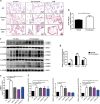Downregulation of lysyl oxidase and lysyl oxidase-like protein 2 suppressed the migration and invasion of trophoblasts by activating the TGF-β/collagen pathway in preeclampsia
- PMID: 30804321
- PMCID: PMC6389995
- DOI: 10.1038/s12276-019-0211-9
Downregulation of lysyl oxidase and lysyl oxidase-like protein 2 suppressed the migration and invasion of trophoblasts by activating the TGF-β/collagen pathway in preeclampsia
Abstract
Preeclampsia is a pregnancy-specific disorder that is a major cause of maternal and fetal morbidity and mortality with a prevalence of 6-8% of pregnancies. Although impaired trophoblast invasion in early pregnancy is known to be closely associated with preeclampsia, the underlying mechanisms remain elusive. Here we revealed that lysyl oxidase (LOX) and LOX-like protein 2 (LOXL2) play a critical role in preeclampsia. Our results demonstrated that LOX and LOXL2 expression decreased in preeclamptic placentas. Moreover, knockdown of LOX or LOXL2 suppressed trophoblast cell migration and invasion. Mechanistically, collagen production was induced in LOX- or LOXL2-downregulated trophoblast cells through activation of the TGF-β1/Smad3 pathway. Notably, inhibition of the TGF-β1/Smad3 pathway could rescue the defects caused by LOX or LOXL2 knockdown, thereby underlining the significance of the TGF-β1/Smad3 pathway downstream of LOX and LOXL2 in trophoblast cells. Additionally, induced collagen production and activated TGF-β1/Smad3 were observed in clinical samples from preeclamptic placentas. Collectively, our study suggests that the downregulation of LOX and LOXL2 leading to reduced trophoblast cell migration and invasion through activation of the TGF-β1/Smad3/collagen pathway is relevant to preeclampsia. Thus, we proposed that LOX, LOXL2, and the TGF-β1/Smad3/collagen pathway can serve as potential markers and targets for clinical diagnosis and therapy for preeclampsia.
Conflict of interest statement
The authors declare that they have no conflict of interest.
Figures






Similar articles
-
Upregulation of miR-29a suppressed the migration and invasion of trophoblasts by directly targeting LOXL2 in preeclampsia.J Hypertens. 2021 Aug 1;39(8):1642-1651. doi: 10.1097/HJH.0000000000002837. J Hypertens. 2021. PMID: 33657581
-
Transcriptome analysis of PPARγ target genes reveals the involvement of lysyl oxidase in human placental cytotrophoblast invasion.PLoS One. 2013 Nov 12;8(11):e79413. doi: 10.1371/journal.pone.0079413. eCollection 2013. PLoS One. 2013. PMID: 24265769 Free PMC article.
-
MicroRNA‑142‑3p inhibits trophoblast cell migration and invasion by disrupting the TGF‑β1/Smad3 signaling pathway.Mol Med Rep. 2019 May;19(5):3775-3782. doi: 10.3892/mmr.2019.9997. Epub 2019 Mar 1. Mol Med Rep. 2019. PMID: 30864732
-
Evolving roles of lysyl oxidase family in tumorigenesis and cancer therapy.Pharmacol Ther. 2020 Nov;215:107633. doi: 10.1016/j.pharmthera.2020.107633. Epub 2020 Jul 18. Pharmacol Ther. 2020. PMID: 32693113 Review.
-
A new role for LOX and LOXL2 proteins in transcription regulation.FEBS J. 2015 May;282(9):1768-73. doi: 10.1111/febs.12961. Epub 2014 Sep 6. FEBS J. 2015. PMID: 25103872 Review.
Cited by
-
A genome-wide CRISPR-Cas9 knockout screen identifies essential and growth-restricting genes in human trophoblast stem cells.Nat Commun. 2022 May 10;13(1):2548. doi: 10.1038/s41467-022-30207-9. Nat Commun. 2022. PMID: 35538076 Free PMC article.
-
Lysyl oxidase like-2 in fibrosis and cardiovascular disease.Am J Physiol Cell Physiol. 2023 Sep 1;325(3):C694-C707. doi: 10.1152/ajpcell.00176.2023. Epub 2023 Jul 17. Am J Physiol Cell Physiol. 2023. PMID: 37458436 Free PMC article. Review.
-
LOXL2 silencing suppresses angiotensin II-induced cardiac hypertrophy through the EMT process and TGF-β1/Smad3/NF-κB pathway.Iran J Basic Med Sci. 2022 Aug;25(8):964-969. doi: 10.22038/IJBMS.2022.63338.13981. Iran J Basic Med Sci. 2022. PMID: 36159334 Free PMC article.
-
Extracellular matrix and pregnancy: functions and opportunities caught in the net.Reprod Biol Endocrinol. 2025 Feb 14;23(1):24. doi: 10.1186/s12958-025-01348-5. Reprod Biol Endocrinol. 2025. PMID: 39953593 Free PMC article. Review.
-
Correlation of Matrisome-Associatted Gene Expressions with LOX Family Members in Astrocytomas Stratified by IDH Mutation Status.Int J Mol Sci. 2022 Aug 23;23(17):9507. doi: 10.3390/ijms23179507. Int J Mol Sci. 2022. PMID: 36076905 Free PMC article.
References
Publication types
MeSH terms
Substances
LinkOut - more resources
Full Text Sources

